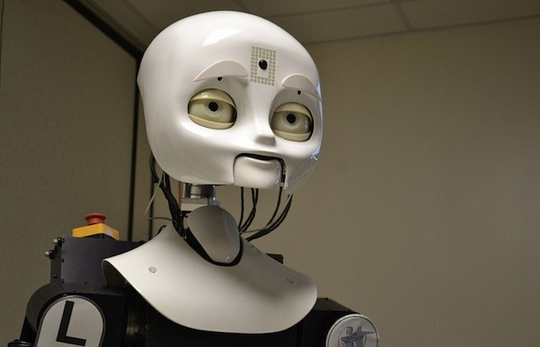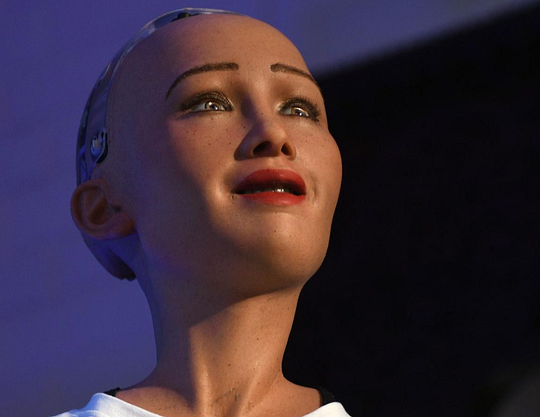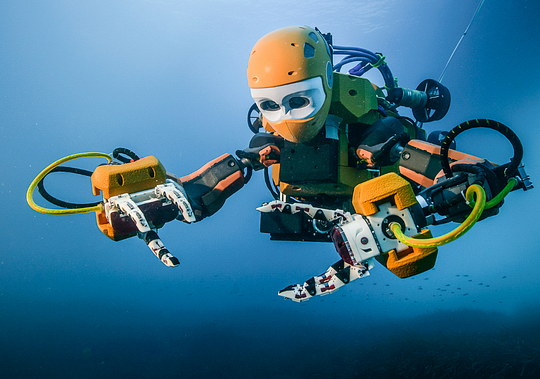
Humans have long been fascinated with the idea of robots — human-like robots. It’s been 50 years since Isaac Asimov, an American writer and professor of biochemistry at Boston University, devised his famous Three Laws of Robotics* — a set of rules designed to ensure friendly robot behavior. Isaac Asimov imagined a futuristic world in which humanoid robots were commonplace and, famously, programmed with the Three Laws of Robotics to help — and not harm — their human counterparts.

Octavia
We’re accustomed to the idea of machines acting like people. We’re even accustomed to the idea of machines thinking in ways that remind us of humans. For example, Octavia, a humanoid robot designed to fight fires on Navy ships, has mastered an impressive range of facial expressions.

Sophia
Sophia, a social humanoid of Hanson Robotics, led by AI developer David Hanson, has a “human-skin” look and more than 50 facial expressions. Yes, we, humans, wish our robots have emotions!

Ocean One
Another amazing robot, named OceanOne, was created inside the Stanford Robotics Lab team led by under Prof. Oussama Khatib, with human skills and aptitudes in mind. OceanOne, a bimanual underwater humanoid robot, has been developed not only to closely mimic the abilities of a human diver, but to work with a team at sea level, who provide cognitive capabilities and expertise.
Despite the fact that “haptic feedback” might not be a term familiar to everyone, you can pretty much guarantee that you’ve used it. Simply put, “haptic feedback”, or ‘haptics’ is the use of touch feedback. In its most basic form, haptics is felt through the vibrations on your smartphone. Reflecting the contact forces back to the operator allows the human controller to share a sense of touch, vital to sensitive operations such as sampling deep-sea habitats or collecting artifacts from shipwrecks.
Now, there are moral aspects here when we have robots that have emotions or other human-only characteristics. These issues are especially well demonstrated in case of Octavia, which is being sent into frightening, painful, or potentially lethal situations in place of less dispensable human teammates, or OceanOne, traveling in deep water where the human cannot survive, taking on highly-skilled underwater tasks too dangerous for human divers, as well as open up a whole new realm of ocean exploration.
The first generation of Robots we are familiar so far with were programmed by Humans.
Now we are at a new stage of robotics when programmed robots are replaced by Machine Learned Robots. The core idea of MLR is that a machine (not a human) builds algorithms to be used for future decision-making while using some past “learning” data. The goal of MLR is to design an efficient algorithm that statistically gives the right answer “almost always”. But here we face a problem…
- “Almost always” doesn’t mean ALWAYS — MLR decisions are not intended to be always right, just good enough in the majority of cases. Now think about your kitchen robot who every morning makes perfect scrambled eggs to you and yet, “only” once in 1,000 times puts a fire to your house… What would you say to that?
- The human can’t understand the reasoning of MLR-built algorithms.
- The human can’t intervene into MLR-built robot — how do you know if the perceived “wrong move” is not the only right one? Humans have no such speed nor the amount of info
There is a lot of food for thought and sometimes we get goosebumps at the clear realization that the robot revolution is happening now, that the world is simply spiraling out of control. But we shall not freak out about it. Whenever there are concerns, there are opportunities.
For example, as R. David Edelman, currently, the director of MIT’s Project on Technology, Economy, and National Security stated in his interview to Wired magazine, that collaborative robots that augment a human’s work might be a great opportunity to bring manufacturing jobs back to the United States. “A lot of folks that I’ve talked to in the industry, particularly the high-tech sector, are wanting to bring as much manufacturing back to the US as possible. There are a few reasons. One, IP protection is of grave and increasing concern as you get to more proprietary robotic systems. Two, a lot of American executives and others are worried about safety and persistence of the Chinese economy.”
A lot of bright people are currently working to build human-like robots that will make impacts on our future lives.
Here is the list of People in robotics you need to know about and you can meet at the conference:
Inventors:
Oussama Khatib
David Hanson — The Man Responsible for the Creation of Sophia
Joe Jones: The Inventor of the Roomba
Investors:
Dmitry Grishin, Grishin Robotics
Josh Wolfe, Lux Capital,
Helen Zelman Boniske, Lemnos
Manish Kothari, SRI Ventures
Julian Counihan, Schematic Ventures.
Wen Hsieh, Kleiner Perkins Caufield Byers
David Weiden — General Partner, Khosla Ventures
*The Three Laws of Robotics are a set of rules devised by the science fiction author Isaac Asimov. The rules were introduced in 1942 are:
- First Law — A robot may not injure a human being or, through inaction, allow a human being to come to harm.
- Second Law — A robot must obey the orders given it by human beings except where such orders would conflict with the First Law.
- Third Law — A robot must protect its own existence as long as such protection does not conflict with the First or Second Laws.
**Sophia is a social humanoid robot developed by Hong Kong based company Hanson Robotics. Sophia was activated on February 14, 2016, and made its first public appearance at South by Southwest Festival in mid-March 2016 in Austin, Texas, United States.



